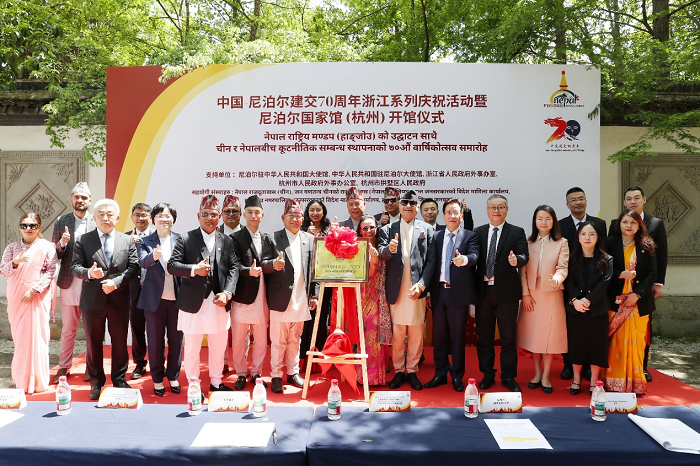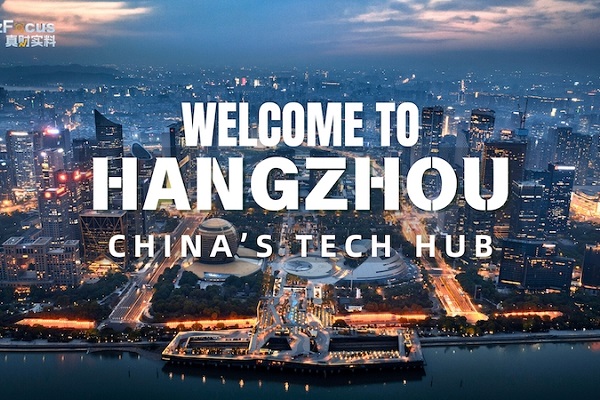AI technologies integrate into Chinese people's daily lives at an accelerating pace

AI Photo: VCG
In a Hangzhou courtroom, a judge prepares to preside over a civil case. The judge logs into a smart judicial decision-making platform, perusing through the case files and in-depth analyses meticulously organized by the system. Once the judge has a firm grasp of the case's fundamentals, the hearing commences. All parties join the virtual court hearing. Just 20 minutes later, a verdict is reached. The large-scale language model drafts the judgment document, which the judge reviews, signs, and then emails to the parties concerned, bringing the case to a close.
In a rehabilitation ward at a hospital in South China's Guangdong Province, a patient dons a multimodal brain-computer interface (BCI) smart headband. Without lifting a finger or uttering a word, the patient can control a tablet computer, adjust the height and position of the nursing bed, operate the room's TV, lights, and air conditioner, or even command a wheelchair to move and direct a robotic arm to fetch a cup of water, all with the simple blink of an eye.
In our daily lives, an ordinary person can now create a lifelike digital avatar within minutes using an app, merely by uploading a photo or a short video. This was scarcely imaginable back in 2020.
These scenes are proof that smart healthcare, an intelligent judiciary, and smart living are no longer distant dreams. Following the widespread acclaim of Chinese artificial intelligence (AI) technologies and products like DeepSeek and the Unitree humanoid robot earlier this year, 2025 has seen an even faster integration of AI into people's daily lives.
What lies ahead for AI research? How can AI assist governments in achieving intelligent governance? And how can it contribute to treating paralysis and other serious diseases? At a recent Wu Wenjun AI Science and Technology Award ceremony, the most prestigious honor in China's AI field, held in Beijing, organized by the Chinese Association for Artificial Intelligence, the Global Times engaged in a discussion with three leading Chinese AI experts - Wu Fei, Director of the Artificial Intelligence Research Institute at Zhejiang University; Li Yuanqing, a professor at the School of Automation Science and Engineering at South China University of Technology; and He Xiaodong, Director of JD Explore Academy - on these topics.
Infinite possibilities
The intelligent trial platform, Phoenix, developed by Wu Fei's team has been rolled out in 55 pilot courts across East China's Zhejiang Province. So far, it has handled over 15,000 cases, boosting judicial efficiency by nearly 40 percent. In total, it has reached more than 10,000 courts nationwide, according to Wu.
The team has also open-sourced the core LegalMind legal large model and the FastSpeech voice synthesis system of the Phoenix platform. These resources are in high demand, with their monthly usage exceeding 1.5 million. They have been instrumental in facilitating the shift in judicial innovation, moving from offline to online hearings, from synchronous to asynchronous processes, and from single-case to multi-case joint hearings, Wu said.
Previously, the judicial process could be time-consuming, Wu said. After the plaintiff filed a lawsuit, the judge had to painstakingly read the complaint, summon all parties to present their testimonies, and then render a verdict based on various materials, debates, laws, regulations, and precedence. Finally, the judge would write and deliver the judgment. If any party was dissatisfied, an appeal could be lodged.
Today, the Phoenix platform streamlines this process. It digitizes and analyzes the documents submitted by both the plaintiff and the defendant, ensuring the judge is well-prepared before the hearing. During the trial, related parties only need to connect via the Internet instead of coming to the court in person. The judge can rely on the platform to ask questions. These improvements jointly help to enhance case handling efficiency significantly. For instance, civil cases in Hangzhou can now be resolved in approximately 20 minutes, according to Wu.
The LegalMind model has an extensive knowledge base, incorporating over 3,000 Chinese laws and more than 50,000 regulations for pretraining. This continuous optimization enhances its logical reasoning and learning abilities. It can handle legal consultation queries through a question-and-answer format, even dealing with multiple-question scenarios, Wu said.
During the model's development, relevant authorities in Zhejiang Province played a crucial role. They organized the heads of civil trial courts from 11 cities to map out the judgment logic for each civil case and construct a knowledge graph of the judgment process. This knowledge graph was then input into the model, teaching the AI system to mimic judges' decision-making. Additionally, the model combines logical reasoning with data retrieval, ensuring the rationality and accuracy of case- handling, according to Wu.
Around 1,200 kilometers away from Hangzhou in the smart ward of the Guangdong Artificial Intelligence and Digital Economy Laboratory in Guangzhou, also known as Pazhou Lab, Li Yuanqing and his team are dedicated to enhancing the BCI AI technology they developed.
This BCI technology can directly interpret brain signals and enable seamless interaction with external devices. It has been a game-changer for patients with high- level paraplegia and the elderly. They can now control wheelchair movement and manage smart ward devices like lights, air conditioners, and nursing beds with their thoughts, significantly improving their quality of life, Li said.
The technology has been applied in several hospitals in Guangdong. Since 2019, 54 patients at the Guangdong Work Injury Rehabilitation Hospital have reaped the benefits, the Global Times learned from the Pazhou Lab.
Beyond rehabilitation and eldercare, this technology has also been applied in psychological intervention, emotional regulation, and even improving children's attention. It could also be a valuable tool in addressing issues like pediatric ADHD, Li said.
Li said that BCI technology is like an "endless frontier" due to its connection with brain research. The exploration of the human brain has no bounds. "In the near future, BCI technology will revolutionize our lives. We can expect to see brain-controlled driving, more advanced brain-controlled wheelchairs, seamless integration of brain functions with robots, enhanced brain functions, and more effective brain function rehabilitation. The possibilities are endless," he said.
Smart life
With the development and maturation of domestic technologies like DeepSeek, AI is rapidly becoming an integral part of our daily lives. The 2025 Chinese government work report proposed further promotion of the "AI plus" initiative, aiming to better integrate digital technology with manufacturing and market advantages to support the extensive application of large models.
In the realm of governance, local governments in China are actively integrating AI into social governance and public service scenarios. In Taiyuan, North China's Shanxi Province, a newly launched AI-powered government assistant has been a boon for new mothers. After a baby is born, they can obtain information regarding household registration, health insurance, and vaccination schedules in less than three seconds on the platform.
In Heilongjiang, AI has been integrated into the citizen hotline. It can transcribe conversations in real-time and summarize them into text, then quickly and accurately route the information to relevant functional departments. In Chenzhou, Hunan, highway police leverage DeepSeek to analyze surveillance videos. This enables them to promptly detect abnormal road events such as emergency lane parking and traffic congestion, and issue timely warnings. In Futian district, Shenzhen, AI-enabled digital employees can achieve over 95 percent accuracy in document formatting corrections and rapidly generate law enforcement documents.
In the healthcare sector, China's first AI pediatrician was put into use at the Beijing Children's Hospital in February. It now participates in multidisciplinary consultations alongside medical experts.
The industrial landscape is also undergoing a rapid transformation. JD's Yan Xi digital human, for example, has achieved large-scale commercialization. It serves over 9,000 merchants and has generated a total economic value of 14 billion yuan, according to He Xiaodong.
Intelligent future
Wu believes that DeepSeek's open-source approach has made AI as accessible as essential utilities like water and electricity. It offers hope for achieving "ubiquitous intelligence, available to everyone, everywhere, at any time."
He echoed Wu. He said that in the future, AI will be deeply integrated into every aspect of daily life, including services, household management, and eldercare.
He deems the emergence of DeepSeek in China as somewhat inevitable. China has a strong application-driven approach in the AI field and maintains an open-minded attitude. Although the open source strategy may seem to disrupt traditional business models, it actually expands application scenarios and attracts more resources, ultimately benefiting the entire AI ecosystem. "There are many similar companies like DeepSeek in China that are also making progress. We can anticipate even more remarkable achievements in the future," he said.
However, both Wu and He acknowledged that current large models still have shortcomings.
When it comes to handling government affairs, for example, current large scale models can only process cases with sufficient prior experience and data, struggling to deal with entirely new and unprecedented situations, Wu noted.
He added that although the application of AI technologies is currently in an explosive growth phase, from a technical standpoint, the industry is in a period of climbing toward the next breakthrough.
"In the basic research stage, there are still many uncertainties. Fundamental issues such as cognitive mechanisms and mathematical principles remain unresolved. This has given rise to the phenomenon of AI 'hallucinations,' which can be categorized as either creative or nonsensical. Reducing nonsensical hallucinations requires in-depth research into cognitive mechanisms," he explained.
AI governance also poses challenges that require a global and multi-level societal effort. Only through healthy competition and cooperation can we accelerate the pace of human technological progress, He said.
-
Inside Hangzhou: China's high-tech dream factory
March 12, 2025



